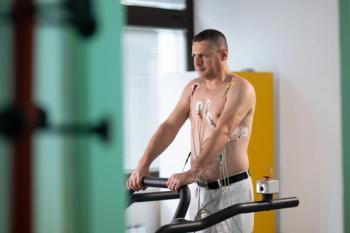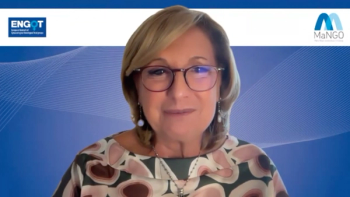
The Global Perspective on Value in Cancer Care
The discussion on value in cancer care was rekindled today at the 50th annual meeting of the American Society of Clinical Oncology, but this time on a global scale. The session, "ASCO/European CanCer Organisation (ECCO) Joint Session: Value and Cancer Care," saw participation from physicians and economists from around the world, with individual perspectives on defining value and the programs being developed to address the issue.
The discussion on value in cancer care was rekindled today at the 50th annual meeting of the American Society of Clinical Oncology, but this time on a global scale. The session, “ASCO/European CanCer Organisation (ECCO) Joint Session: Value and Cancer Care,” saw participation from physicians and economists from around the world, with individual perspectives on defining value and the programs being developed to address the issue.
The first talk was “ESMO-EONS: Value and the Exchange Between Physicians, Nurses, and Patients,” by Elisabeth de Vries, MD, PhD, University Medical Center Groningen, Netherlands. She is a member of the Magnitude of Clinical Benefit Scale task force.
Dr de Vries started off with background information on cancer drug use in Europe, and how the cancer drug development process is influenced by the European Society for Medical Oncology (ESMO).
As was presented in many other sessions regarding the survival of cancer patients in the United States, the 5-year relative cancer survival in Europe has increased during the time period of 1999 to 2007. However, cost of treatment is only burgeoning. And approval by regulatory agencies does not necessarily translate into patient access to efficient therapies. So where lies the problem, and what is the relevance of the cost of cancer drugs?
Looking at imatinib as an example, Dr de Vries presented a pricing plot showing that the drug cost the most in the United States, but substantially less in Europe and other countries around the globe.
She went on to state that there are also differences in access to new anticancer drugs in Europe―differences in price, differences in healthcare costs, and differences in time to access after European Medicines Agency (EMA) approval. These disparities are associated with various issues, one of which is the cost of the drug and reimbursement.
Among European nations, a 1.8-fold difference in the cost of trastuzumab has been identified. Additionally, a difference in time to availability after EMA approval has also been observed. Bottom line, major disparities in cancer outcomes might be a result of lack of timely access to anticancer drugs.
With the hope of standardizing policies and easing patient access to novel treatments, ESMO is developing the Magnitude of Clinical Benefit Scale. How will the scale be used? EMA-approved drugs will be scaled by the task force, and drugs with the highest value will then be promoted.
Various factors will contribute to the scale, including, among others, quality of life (QoL), overall survival (OS), progression-free survival (PFS), prognosis of condition, toxicity, hazard ratio, long-term survival, and rate of response. These factors will be used to determine the magnitude of clinical benefit. “We did not factor costs into the equation due to the heterogeneity that exists across Europe,” said Dr de Vries.
"We believe the ESMO scale will be constantly evolving with the availability of increasing efficacy and toxicity data as the treatment is used by the wider population."
The scales, she noted, are distinct for curative versus palliative settings. PFS, for example, can never qualify for a grade 4 score as a primary end point, but could be a secondary end point to be considered concurrent with OS, toxicity, and QoL.
The major heterogeneity in drug price and access across Europe can result in inequality in optimal care. The ESMO scale grades drugs to determine the ideal drugs that should be immediately accessible to patients across Europe.2 The task force plans to develop and further mature this grading scale by collaborating with sister societies to generate as much data as possible to improve patient access.
Next on the panel was Richard Sullivan, MD, PhD, Kings Health Partners Integrated Cancer Centre, London, England, who discussed “Cancer Care in Cost-Restrained Health Care Systems.” Dr Sullivan, who’s also involved in developing the ESMO scale, conducts a research program that extends from the sociopolitical policy of global cancer (OncoPolicy) to the development of public health systems in high-risk conflict areas, focusing on DR Congo, Afghanistan, and Libya. In OncoPolicy, he recently led the first major Lancet Oncology Commission that examined the affordability of cancer in high-income countries.1
“All healthcare systems are struggling to deliver affordable and equitable cancer care,” said Dr Sullivan. Cancer care operates as a complex adaptive system, unlike other normal systems, he said, in that:
- It is non-linear, dynamic, and can even appear chaotic.
- Individuals who comprise the system behave according to social and structural norms rather than to the needs of the system.
- Goals and behaviors are often in conflict.
- There is no single point of control.
“Our global economic systems have become addicted to the returns generated by cancer care and treatment,” he said. Income equality is worsening globally, and we need to gain a better handle on value and equitability. Research has shown that three-fifths of the global population has less than 5% of global wealth―how can that provide equitable cancer care?
Additionally, the cancer research portfolio is extremely narrow when it comes to drug discovery and fundamental biology. The sheer volume and pace of outputs is outstripping the ability of policy makers. “It’s harder to make cost-effective and rational decisions to provide or make available efficient therapy to the population as a whole,” said Dr Sullivan.
Our cancer care systems are framed by behaviors and cultures that are not coterminus with affordability and equity. Patients can have very high expectations from their cancer treatment. Therefore, “How we frame the debate becomes as important as the content of the debate,” Dr Sullivan noted.
Identifying sites for fiscal controls and sustainability mechanisms is an uphill battle, and recognizing problem areas to adapt cost-effectiveness is very hard. This is even harder in developing nations like India, where cancer care is associated with 67% of out-of-pocket expenditure with financial hardship and 21% catastrophic expenditure.
Most of our societies are reaching limits on affordability or what we are willing to pay. How do we then get value-based pricing?
Balancing costs and benefits with toxicity of new technologies needs consideration. New, extremely efficient drugs (such as the developing immuno-oncology molecules) could be the stepping stone in this setting.
“Value-based pricing without universality/universal healthcare does not work,” concluded Dr Sullivan. “Reform can never stop, as exogenous factors emerge and societal demands and values change.”
The final presentation in the session, presented by Lowell E. Schnipper, MD, Beth Israel Deaconess Medical Center, discussed “American Perspective on Globally Defining Value in Cancer Care.”
The United States spends a great deal more on healthcare than many European nations, and the data are spotty.
“Why do we emphasize value?” asked Dr Schnipper. Drug price is a part of the high cost of cancer care, but not the only problem, by any means. Outside of the United States, clinical aspects are used for assessment first, and then the results are applied for price negotiation.
He reiterated that the physician has an active role to play in value determination and cost regulation, and ASCO is making efforts to help define value in cancer care with the long-term goal of integrating these suggestions in the clinic.
His final thoughts were that the value model must also be adaptable for early disease settings, which is ongoing.
The closing remarks were provided by Clifford Hudis, MD, Memorial Sloan Kettering, and the acting President of ASCO. “We are entirely dependent on industry for both innovation and cash flow. But we want to develop a dialogue and generate communication when it comes to drug costs.”
References
1. ESMO clinical benefit scale: project background and overview. European Society for Medical Oncology website. http://www.esmo.org/content/download/16414/287782/file/ESMO-Clinical-Benefit-Scale.pdf. Accessed June 2, 2014.
2. Prof Richard Sullivan MD, PhD. World Cancer Congress website. http://www.worldcancercongress.org/prof-richard-sullivan-md-phd. Accessed June 2, 2014.
Newsletter
Stay ahead of policy, cost, and value—subscribe to AJMC for expert insights at the intersection of clinical care and health economics.













































